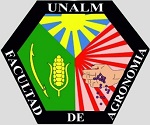Genetic behavior for seed yield and yield components in sesame (Sesamum indicum L.) under normal irrigation and water stress conditions
DOI:
https://doi.org/10.21704/pja.v5i1.1656Keywords:
Sesame, Sesamum indicum, Half diallel analysis, Heterosis, Combining ability, Gene action, Irrigation.Abstract
Six divergent genotypes of sesame (Sesamum indicum L.) were crossed using a half diallel excluding reciprocal crosses, to estimate heterosis, combining ability and nature of gene action for studied traits under two irrigation regimes. The two irrigation regimes were normal irrigation conditions with amount of applied water 5952.38 m3/ha and water stress conditions with amount of applied water 2976.19 m3/ha at Etay-El-Baroud Agricultural Research Station, Behaira governorate, Agricultural Research Center, Egypt during 2019 summer season. A randomized complete block design with three replications was used for each irrigation regimes. The variation of genotypes and their components from parents, crosses and parents versus crosses were highly significant for all studied traits under both irrigation regimes and their interactions with irrigation. Variation attributable to general and specific combining ability was highly significant for seed yield and yield components under both irrigation regimes. The parents L92 and L110 were the best combiners for seed weight per plant and most of its components under both irrigation regimes. The best F1 cross combination was L92 × L110 in specific combining ability and heterotic effects over mid- and better-parents under both irrigation regimes for seed weight per plant and most of its attributes. The preponderance of additive gene action in the inheritance of most studied traits was observed, that further confirmed by its significance and the value of average degree of dominance exceeding the unity. Narrow-sense heritability varied from 0.19 for number of branches per plant to 0.47 for 1000 seed weight under normal irrigation, whereas, under water stress conditions, it ranged from 0.14 for number of branches per plant to 0.42 for fruiting zone length. Parents L95 and L93 under normal irrigation and L93 and L110 under water stress conditions carried mostly genes with dominant effects for seed weight per plant, in contrary, L92 and L110 under normal irrigation and L92 and L12 under water stress conditions carried mostly recessive alleles for seed weight per plant. Hence, the results will be used to develop a sesame breeding scheme at Etay-El-Baroud Agricultural Research Station.
Downloads
References
Abd EL-Satar, M. A., Ahmed Fadia, H. A., & Elnenny, E. M. M. (2016). Line × tester analysis of yield and its components for high plant density tolerance in sesame. Egyptian Journal of Plant Breeding, 20(6), 1009–1034. Doi:10.12816/0046416
Association of Official Analytical Chemists (1990). Official Methods of analysis. 15th Ed. Virginia, USA.
Azeez, M. A., & Morakinyo, J. A. (2014). Combining ability studies and potential for oil quality improvement in sesame (Sesamum indicum L.). Journal of Agroalimentary Processes and Technologies, 20(1), 1–8.
Baker, R. J. (1978). Issues in diallel analysis. Crop Science, 18(4), 533–536. https://doi.org/10.2135/cropsci1978.0011183X001800040001x
Bhutia, N. D., Seth, T., Shende, Varun, D., Dutta, S., & Chattopadhyay, A. (2014). Estimation of heterosis, dominance effect and genetic control of fresh fruit yield, quality and leaf curl disease severity traits of chilli pepper (Capsicum annuum L.). Scientia Horticulturae, 182, 47–55. https://doi.org/10.1016/j.scienta.2014.11.017
Fahmy, R. M., Abd EL-Satar, M. A., & Hassan, T. H. A. (2015). Heterosis, combining ability and gene action for yield and its attributes of F1 crosses in sesame. Egyptian Journal of Plant Breeding, 19(3), 917–943.
Griffing, B. (1956). Concept of General and specific combining ability in relation to diallel cross system. Australian Journal of Biological Sciences, 9, 462–493.
Hayman, B. I. (1960). Theory and analysis of diallel crosses. Genetics, 45, 155–172.
Hayman, B. I. (1954a). The analysis of variance of diallel tables. Biometrics, 10, 235–244.
Hayman, B. I. (1954b). The theory and analysis of diallel crosses. Genetics, 39, 789–809.
Ismail, S., Khan, F. A., Mubarak, S., & Kanwal, B. (2020). Heterosis in relation to combining ability studies in sesame (Sesamum indicum L.). Journal of Genetics, Genomics and Plant Breeding, 4(2), 68–75.
Jackson, M. L. (1973). Soil chemical analysis. Prentice-Hall, Inc.; Englewood Cliffs. NJ, USA.
Jeeva, G., Saravanan, K., & Sowmiya, C. A. (2020). Assessment of combining ability and standard heterosis through diallel analysis in sesame (Sesamum indicum L.). Electronic Journal of Plant Breeding, 11(2), 386–391.
Jinks, J. L. (1954). The analysis of continuous variation in a diallel cross of Nicotiana rustica varieties. Genetics, 39, 767-788.
Johnson, L. P. V., & Aksel, R. (1964). The inheritance of malting quality and agronomic characters in a diallel cross of barley. Canadian Journal of Genetics and Cytology, 6, 178–200.
Jones, R. M. (1965). Analysis of variance of the half diallel table. Heredity, 20, 117–121.
Kearsy, M. J. (1965). Biometrical analysis of a random mating population: a comparison of five experimental designs. Heredity, 20, 205-235.
Mather, K., & Jinks, J. L. (1982). Biometrical genetics, 3rd edition. London Chapman and Hall.
Mather, K., & Jinks, J. L. (1971). Biometrical genetics. Chapman and Ha 11 Ltd.
MS-EXCEL (2007). Microsoft software excel.
Ramesh, N., Shekhawat Macwana, S. S., Choudhary, R. & Patel, B. R. (2014). Line × tester analysis in sesame (Sesamum indicum L.). The Bioscan, 9(4), 1657–1660.
Salimath, P. M. & Bahl, P. N. (1985). Heterosis and combining ability for earliness in chickpea (Cicer arietinum L.). Indian Journal of Genetics and Plant Breeding, 45, 97–100.
Steel, R. G., Torrie, J. H., & Dickey, D. A. (1997). Principles and Procedures of Statistics. A Biometrical Approach 3rd Edition. McGraw Hill book Co. Inc. New York, U.S.A.
Wigan, I. G. (1944). Balance and potence in natural populations. Journal of Genetic, 46, 150–60.
Downloads
Published
Issue
Section
License
Copyright (c) 2021 Suzan Abd El- Latif Kamel Ibrahim, Mohamed Ali Abdelsatar, Mohamed Abd El-Raheem Ahmed, Magdy M. Niazy

This work is licensed under a Creative Commons Attribution 4.0 International License.











